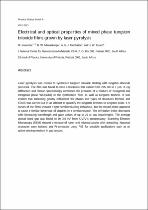 ResearchSpace
ResearchSpace
Electrical and optical properties of mixed phase tungsten trioxide films grown by laser pyrolysis
JavaScript is disabled for your browser. Some features of this site may not work without it.
- ResearchSpace
- →
- Research Publications/Outputs
- →
- Journal Articles
- →
- View Item
| dc.contributor.author |
Govender, M

|
|
| dc.contributor.author |
Mwakikunga, Bonex W

|
|
| dc.contributor.author |
Machatine, AGJ

|
|
| dc.contributor.author |
Kunert, HW

|
|
| dc.date.accessioned | 2014-09-22T13:46:58Z | |
| dc.date.available | 2014-09-22T13:46:58Z | |
| dc.date.issued | 2014-02 | |
| dc.identifier.citation | Govender, M, Mwakikunga, B.W, Machatine, A.G.J and Kunert, H.W. 2014. Electrical and optical properties of mixed phase tungsten trioxide films grown by laser pyrolysis. Physica Status Solidi A, vol. 11(2), pp 349-354 | en_US |
| dc.identifier.issn | 1862-6300 | |
| dc.identifier.uri | http://onlinelibrary.wiley.com/doi/10.1002/pssc.201300212/pdf | |
| dc.identifier.uri | http://hdl.handle.net/10204/7686 | |
| dc.identifier.uri | https://doi.org/10.1002/pssc.201300212 | |
| dc.description | Copyright: 2014 Wiley-VCH Verlag. This is an ABSTRACT ONLY. The definitive version is published in Physica Status Solidi A, vol. 11(2), pp 349-354 | en_US |
| dc.description.abstract | Laser pyrolysis was chosen to synthesize tungsten trioxide starting with tungsten ethoxide precursor. The film was found to have a thickness that varied from 205 nm to 1 µm. X-ray diffraction and Raman spectroscopy confirmed the presence of a mixture of hexagonal and tetragonal phase WO(sub3) in the synthesized film, as well as tungsten bronzes. It was evident that annealing greatly influenced the phases and types of structures formed, and EDXS was carried out in an attempt to quantify the tungstate bronzes to tungsten oxide. I-V curves of the films showed n-type semiconducting behaviour, but the mixed phase appeared to cause a similar behaviour of dopants in a semiconductor. The refractive index decreased with increasing wavelength and gave values of up to 21 at low wavelengths. The average optical band gap was found to be 3.6 eV from UV/Vis spectroscopy. Scanning Electron Microscopy (SEM) showed a mixture of nano- and microstructures after annealing. Nanorod structures were isolated and Pt-contacted using FIB for possible applications such as an active sensing medium in gas sensors. | en_US |
| dc.language.iso | en | en_US |
| dc.publisher | Wiley-VCH Verlag | en_US |
| dc.relation.ispartofseries | Workflow;13365 | |
| dc.subject | Laser pyrolysis | en_US |
| dc.subject | Tungsten trioxide | en_US |
| dc.subject | Nanorods | en_US |
| dc.subject | FIB-SEM | en_US |
| dc.subject | Gas sensors | en_US |
| dc.title | Electrical and optical properties of mixed phase tungsten trioxide films grown by laser pyrolysis | en_US |
| dc.type | Article | en_US |
| dc.identifier.apacitation | Govender, M., Mwakikunga, B. W., Machatine, A., & Kunert, H. (2014). Electrical and optical properties of mixed phase tungsten trioxide films grown by laser pyrolysis. http://hdl.handle.net/10204/7686 | en_ZA |
| dc.identifier.chicagocitation | Govender, M, Bonex W Mwakikunga, AGJ Machatine, and HW Kunert "Electrical and optical properties of mixed phase tungsten trioxide films grown by laser pyrolysis." (2014) http://hdl.handle.net/10204/7686 | en_ZA |
| dc.identifier.vancouvercitation | Govender M, Mwakikunga BW, Machatine A, Kunert H. Electrical and optical properties of mixed phase tungsten trioxide films grown by laser pyrolysis. 2014; http://hdl.handle.net/10204/7686. | en_ZA |
| dc.identifier.ris | TY - Article AU - Govender, M AU - Mwakikunga, Bonex W AU - Machatine, AGJ AU - Kunert, HW AB - Laser pyrolysis was chosen to synthesize tungsten trioxide starting with tungsten ethoxide precursor. The film was found to have a thickness that varied from 205 nm to 1 µm. X-ray diffraction and Raman spectroscopy confirmed the presence of a mixture of hexagonal and tetragonal phase WO(sub3) in the synthesized film, as well as tungsten bronzes. It was evident that annealing greatly influenced the phases and types of structures formed, and EDXS was carried out in an attempt to quantify the tungstate bronzes to tungsten oxide. I-V curves of the films showed n-type semiconducting behaviour, but the mixed phase appeared to cause a similar behaviour of dopants in a semiconductor. The refractive index decreased with increasing wavelength and gave values of up to 21 at low wavelengths. The average optical band gap was found to be 3.6 eV from UV/Vis spectroscopy. Scanning Electron Microscopy (SEM) showed a mixture of nano- and microstructures after annealing. Nanorod structures were isolated and Pt-contacted using FIB for possible applications such as an active sensing medium in gas sensors. DA - 2014-02 DB - ResearchSpace DP - CSIR KW - Laser pyrolysis KW - Tungsten trioxide KW - Nanorods KW - FIB-SEM KW - Gas sensors LK - https://researchspace.csir.co.za PY - 2014 SM - 1862-6300 T1 - Electrical and optical properties of mixed phase tungsten trioxide films grown by laser pyrolysis TI - Electrical and optical properties of mixed phase tungsten trioxide films grown by laser pyrolysis UR - http://hdl.handle.net/10204/7686 ER - | en_ZA |





